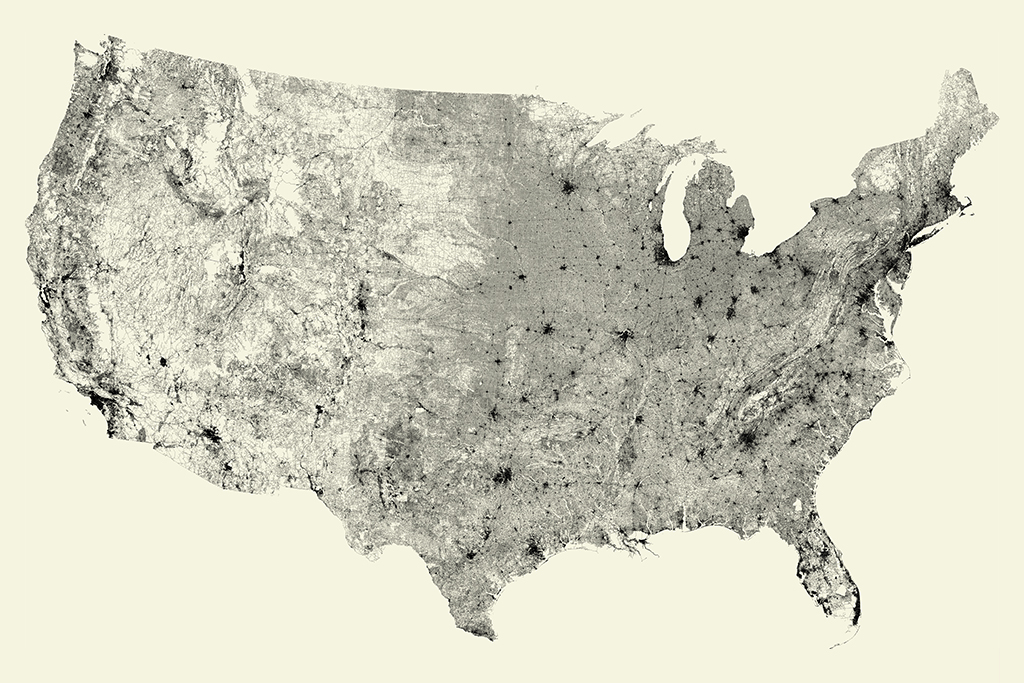
There is No Antonym for Subdivision
Rob Gorski
2012
The English language does not have a fitting opposite the word subdivide, strangely. Combine, reconstitute, aggregate, multiply, unite and others come close, but none serve as antonyms in the context we use subdivision and none are closely related to economic principles underlying the way we subdivide. This nuance within our language signifies a subtle but very large cultural theme underlying almost everything else that we undertake as individuals and as a society. With the benefit of modern data aggregation and visualization it is clear that we have had many irrational blind spots in our historical land use patterns. How we arrived at the satellite images of today from a native environment that existed only a few centuries ago is fascinating. Rabbit Island adds relief to this idea by offering well-controlled exhibition within finite borders. Rabbit Island is a rare gem—an undivided parcel that has escaped the normative pattern of subdivision.
In the 1400’s America welcomed its first European settlers and small sections of forest were cleared and settled. The whole of the continent thus suffered its first cuts. Over the next several generations these initial events evolved slowly into the divided parcels we have today and the acts themselves become, perhaps, the enduring metaphor for the larger American settlement experience. Purchase, profit, divide, repeat… a way of life goes on and on, though never in reverse. An abundance of forest has been swapped for an abundance of subdivision.
Conservation was a relatively late idea in the context of America’s history (it wasn’t until 1872 that the first national park was created) and today the commodification of remaining developable land around the remaining open spaces continues and new, ever-smaller lines in the land map books continue to be drawn. This change plods along so slowly as to hardly be perceptible from within the daily routine, but lots and parcels are continually marketed and cut into sections, acres, portions of acres, square feet, etc. Final lines are being drawn. Get yours while you still can, the cry of real estate agent goes. Prices only go up. Supply will never change. The system will never move in reverse.
I protest this idea. The fact that subdivision happened and continues to happen with such binary imbalance in winner-take-all fashion, and that land is then taken off the table, is, on a fundamental level, uncivilized. As it currently stands one of two things generally happens to land within the framework of our cultural practice: 1) conservation gets to a parcel of land first and locks it in, or, 2) subdivision gets first crack and development progresses without regard for collective ideas and smaller units of land are ever-passed to successive generations. The larger picture on the map only becomes more polarized as time horizons are extrapolated further into the future. This binary historical example has obvious limitations that are in conflict with contemporary understanding. In a civilization that no longer has the luxury of new frontier, it is only logical that recycling of existing land, in a manner consistent with reason and scientific advance, becomes a basic requirement for maintaining civilization. Yet thus far in our history this has not been conceived on an organized scale. It doesn’t even appear to be part of any serious conversation. Our society’s founding documents and legal precedents were, after all, conceived in a time flush with frontier. Foresight apparently has its limits.
It is clear that very little opportunity for parcelization and road access has been missed and open space in America has suffered a death by a thousand cuts, leaving only remnants of land. Development has most certainly won a lopsided victory over conservation in the binary American historical experience. Only about 30% of land is set aside in programs for the public intended to retain or celebrate broad stretches of natural function. Of this allotment the vast majority is unevenly distributed in western states and Alaska, and, more specifically, concentrated in areas of uneven terrain (mountains), areas containing an excess of water (everglades), areas without enough water (deserts), or regions having inclement weather patterns (far northern latitudes). If you scroll across the country from the perspective of a Google satellite it becomes evident that there is not a single area of ecologically important scale that does not fall under one of these categories that has been given pardon from development.
As a result “locavorism” with respect to visiting intact natural ecosystems is not possible for the majority of the population in our country. Thus, a divide is formed whereby cultural institutions primarily benefit those living proximate to urban civilization while intact wilderness areas, northern forests, southern swamps and southwestern deserts serve mainly the relatively light population density surrounding them. In very few places do the two ideas exist reasonably adjacent to one another and almost nowhere has nature been celebrated simply because it is nature without a caveat. Rabbit Island can perhaps claim a cold winter for receiving pardon from historical development, though the fact that it was given reprieve at all at this point in history is amazing.
Empirically the evidence of land division is striking and what has been lost in most places east of the Rockies or in states without long winters is profound: anything involving systems, ideas, or populations that cross individual property lines, migrations, salmon runs, climax forest communities, apex predators, clean rivers, expansive views, dark night skies and stars, the fundamental experience of uninterrupted nature, etc. Certainly we value these things and our heritage is founded on them, yet, peculiarly, there is no organized mechanism to un-divide land hundreds of years after we started cutting it up. Why is this? This is a big question for society and perhaps—and in all seriousness—is on equal footing with the big questions of previous generations: Why were women not allowed to vote? Why were unions allowed when before there were none? Why was Medicare created? Why were black children and white children assigned different schools? In hindsight it appears absurd, of course, that there were times when such unjust disparities went without recognition. So too does it seem absurd that society has no way to un-divide land on an ecological scale with the intention of giving people reasonable access to the fundamental rules that nature provides. Will the next several hundred years of American experience witness a continuation of the historical example of subdivision or will the pendulum swing in a new direction given our collective understanding that now spans from DNA to Google Earth? It seems an obvious inference to suggest that something must change. This is not to say that civilization should move in reverse or that technology should be shunned, but simply that it would be an advancement if nature and the urban environment were organized more rationally so as to maintain a full spectrum of experience including the untouched, the gridded and everything in between—on a more local level. A mechanism for this does not exist. Herein lies vast potential for things to be organized more intentionally for the benefit of all.
Our predecessors have subdivided relentlessly and our system is set-up only to continue this. Apart from the few sparks of genius, foresight and political will that popped up along the way (national parks, national forest system, private preservation, etc.) as we moved westward from Plymouth Rock our modern maps illustrate the unintended consequence of our development heritage. It is striking in aggregate.
Land is generally purchased on an open market with two motivating premises: development and profit. Historically these ideas have manifested themselves in various forms of subdivision and parcelization. (Think of a farm that was nearby when you were a kid that was bought and turned into a subdivision, or the brownstone single family house that was purchased and renovated into several one bedroom apartments, or even the field and forest that was there before the row of brownstones even existed. Consider the island of Manhattan—the ultimate example of land use study—sold to Peter Minuit in 1626 by the Lenape tribe to manifest itself as smaller and smaller subunits of private property over time). The common thread in all of these transactions of property is that the effect on the integrity of the land is never part of the bottom line. And the process rarely moves in reverse. In the end because of our society’s individual liberty and participation in a market that does not fully value the costs of development we have had the freedom to historically subdivide without the requirement of foresight. When these subdivisions are summed we see that there are significant unintended consequences: namely, there isn’t very much land left that isn’t subdivided. Collectively this limits opportunity for citizens to observe intact open spaces that resemble whatsoever their historical baseline, especially near population centers. Indeed this is an odd and ironic historical loophole in the code of American ‘liberty’ and ‘freedom’.
Subdivision is, of course, against everything that Rabbit Island stands for. Rabbit Island will never be subdivided and the miracle that Rabbit Island remained unsubdivided and unlumbered when it was purchased in 2010 is its most remarkable feature.
The native environment of Rabbit Island juxtaposed to contemporary society is intriguing because the island retains rare fundamentals that can figuratively represent many parts of life (arts, civil discourse, sciences, food, culture, conservation, reclamation, government), and its intact, natural purity and strict isolation make it a unique location to illustrate contrasts. The human mind is generally drawn to things organized well and the fact that Rabbit Island is 90 undeveloped acres is the middle of a lake makes it very different from 90 acres in the countryside surrounded by roads, subdivisions and farms, etc. It is also very different from 90 acres surrounded by millions of acres of wilderness within a vastly larger national park. It is circumscribed and thus very tangible to the human mind. This isolation doesn’t allow “cheating” when experimenting with sustainability projects and stands as a simple analogy upon which one can attempt to tip some of society’s conclusions upside down.
In the end the island leads to the question “what if things were different” and challenges one to act on this. This underlying theme is admittedly very much a work in progress and each person who visits the island will potentially interpret this idea very differently, though hopefully in time a concrete set of observations and rules can come of the overall experience. The Rabbit Island concept leads one to attempt to synthesize the world in some sort of fundamental order. Further, it forces one to assign values and pass judgments regarding larger society—a society which has, in many senses, already played its cards and passed its own judgments (for better or worse). It inspires ideas related to medicine, naturalist thought, the suburbs, what is considered classic, what is considered art, etc.
Overall, in life art plays a significant role, but it is not in and of itself encompassing. The same is true of activity on the island—politics, policy, finance, society, etc. All maintain relevance—albeit from a perspective founded in the baseline of wilderness/frontier. Wilderness, after all, is said to hold the answers to questions we as a society have not yet learned to ask.
Perhaps then Rabbit Island’s highest intention is to serve as a symbol of the larger society rather than solely as a studio for an artist or group of artists singularly. In that sense the entire project becomes a work of art.
Image: ‘All Streets’ by 3rd Floor at Fathom.
